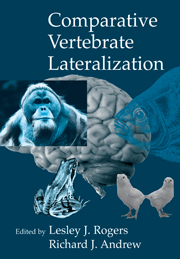Book contents
- Frontmatter
- Contents
- List of Contributors
- Preface
- Introduction
- Part one Evolution of lateralization
- Part two Development of lateralization
- 5 Behavioural development and lateralization
- 6 Factors affecting the development of lateralization in chicks
- 7 Ontogeny of visual asymmetry in pigeons
- 8 Development of laterality and the role of the corpus callosum in rodents and humans
- 9 Posture and laterality in human and non-human primates: Asymmetries in maternal handling and the infant's early motor asymmetries
- Part three Cognition and lateralization
- Part four Lateralization and memory
- Epilogue
- Author Index
- Subject Index
- Richard Andrew
8 - Development of laterality and the role of the corpus callosum in rodents and humans
Published online by Cambridge University Press: 10 December 2009
- Frontmatter
- Contents
- List of Contributors
- Preface
- Introduction
- Part one Evolution of lateralization
- Part two Development of lateralization
- 5 Behavioural development and lateralization
- 6 Factors affecting the development of lateralization in chicks
- 7 Ontogeny of visual asymmetry in pigeons
- 8 Development of laterality and the role of the corpus callosum in rodents and humans
- 9 Posture and laterality in human and non-human primates: Asymmetries in maternal handling and the infant's early motor asymmetries
- Part three Cognition and lateralization
- Part four Lateralization and memory
- Epilogue
- Author Index
- Subject Index
- Richard Andrew
Summary
The Origins of Brain Lateralization in Animals
From the perspective of a new century, it seems difficult to comprehend that only 30 years ago no one believed that animals had lateralized brains and asymmetrical behaviours. Indeed, the conventional dogma was that humans were uniquely different from all other animals in having handedness, brain laterality and speech. The first two functions have now been well established in animals and the third is under serious challenge (Savage-Rumbaugh et al., 1993).
Before addressing these issues, it is necessary to make a distinction between brain lateralization for individual animals and brain lateralization at the population level (Denenberg, 1981). If the population is lateralized (e.g. handedness in humans), then it is obvious that the individuals within that population are lateralized. However, individual animals can be lateralized even when there is no population asymmetry. Thus, Collins (1977) found that 50% of mice used their right paws in reaching for food and 50% used their left. Each animal was given 50 trials and most were found to be strongly biased one way or the other, thereby showing strong asymmetry at the individual level, but no asymmetry at the population level.
The first definitive evidence for population behavioural asymmetry in non-humans was Nottebohm's paper in 1970 reporting that song production in the chaffinch was under the control of the left half of the syrinx (the vocal organ of birds).
- Type
- Chapter
- Information
- Comparative Vertebrate Lateralization , pp. 274 - 305Publisher: Cambridge University PressPrint publication year: 2002
- 11
- Cited by



